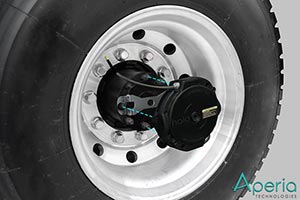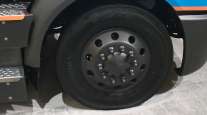Proper Truck Tire Pressure On the Go, Promises California Firm

The lightbulb moment came when Brandon Richardson, a former Detroit automotive engineer, had a tire go flat because it was underinflated.
“We’re all guilty of negligence on vehicle maintenance,” said Josh Carter, who joined forces with Richardson to invent a device designed for big-rig trucks that automatically inflates tires while the vehicle is on the road.
They started a Burlingame, California-based company called Aperia. Its product, Halo, is a 5-pound pump that’s bolted onto the center of a wheel — a task that takes about five minutes. It’s powered by the wheel’s rotation, similar to the way a self-winding watch works. Users enter a target pressure setting. When the air in the tire needs topping off, Halo pumps until the target is reached.
It may sound like a trivial problem. But for commercial fleets of 18-wheel trucks that rack up tens of thousands of miles a year, tire inflation is a big deal, affecting gas mileage, tire life and safety.
Big rigs get lousy mileage, generally 6 or 7 miles per gallon. Properly inflated tires reduce drag as a vehicle rolls down the road, thus increasing fuel efficiency.
“Tire pressure is a real problem,” said Mike Roeth, executive director of the nonprofit North American Council for Freight Efficiency. “Drivers don’t check it. Studies over the past 20 years show a lot of tires are underinflated.”
Tires are expensive. “Eighteen tires cost 500 bucks a pop,” Carter said. “Big rigs driving 100,000 miles a year chew through tires. Optimizing tire inflation extends tire life,” he said.
Proper inflation also helps prevent blowouts. Most on-road tire failure stems from excessive heat generated by underinflated tires, Carter said. “Tire failure is bad for the vehicle itself and potentially even more dangerous for neighboring vehicles from the tire scraps littered across the highway.”
Halos are now installed on about 10,000 trucks in 170 fleets, Carter said. That’s a modest sliver of the estimated 2.4 million big rigs in the U.S. The cost is about $2,400 for enough devices to cover an 18-wheel tractor-trailer, but Carter said the trucks recoup that amount within a year through better fuel efficiency. (The devices are currently too pricey to be practical for cars, which use cheaper tires than trucks.)
Aperia, with 40 employees, makes the Halo devices at a contract manufacturing facility in San Leandro, California, and recently raised $16 million, bringing its total funding to $29 million. Halo-like technology eventually could be built into tires; Aperia has a partnership with tire-maker Michelin.
Down the road — pun intended — Halo can help self-driving cars and trucks. “As we move toward humans being less and less relied upon for vehicle maintenance and upkeep, there’s a significant benefit of automatic tire inflation,” Carter said.
Mountain View, California’s Peloton Technology is working on a form of automation called truck platooning — having a lead truck use technology to control one or more following trucks driving in close formation as a way to reduce wind resistance and increase fuel efficiency. The company installed Halos on its initial prototype trucks.
“We’re focused on developing our truck platooning and automation system, so if we don’t have to worry about the tires, that is great,” said Josh Switkes, Peloton’s founder and CEO. “Tire pressure is one of those things it’s easy to forget you need to check. Halo has worked great, with no problems.”
Carter said Aperia is in talks with Otto, the self-driving truck startup that Uber bought this summer.
Aperia isn’t the only firm in the market. A Texas company called PSI is the leader in automatic tire inflation, according to Roeth of the freight council, with an air compressor system in use on about half of the nation’s truck trailers. But its system does not work on truck cabs, also called tractors — which get more wear and tear, as they may swap out freight trailers and continue driving.
“The tractors get about three times the miles as the trailers,” Roeth said. “Aperia is the first inflation system on the market that’s cost-effective for the tractors. It sits there and spins, inflating the tires over time. It’s a much slower inflation than an air compressor but the rate is sufficient.”
Halo and other automatic-tire-inflation systems could help companies comply with new EPA rules taking effect in 2018 that mandate better fuel economy for trucks, he said.
Various companies are working on automatic systems for other vehicle needs — something that will take on increased importance as self-driving technology spreads. Tesla has a snake-like electric charger that automatically plugs itself into cars. Solutions for gas refueling range from low tech (on-demand fuel tankers) to high tech (robotic gas pumps for drive-through refueling).
“It’s federally mandated that drivers do pretrip inspections [including tire pressure], but everyone in the industry will tell you that doesn’t happen,” Carter said. “We are checking tire pressure every day by blending Silicon Valley innovation with Detroit automotive tech.”




